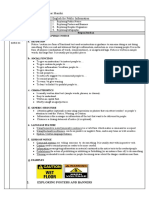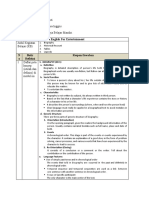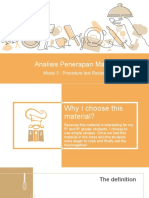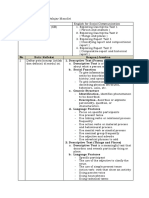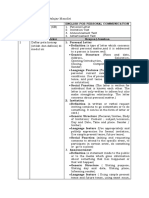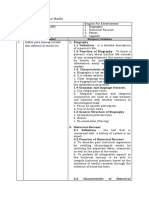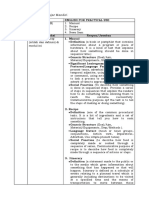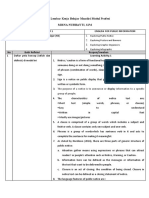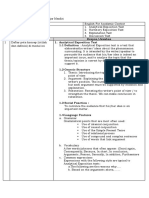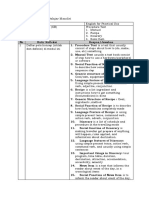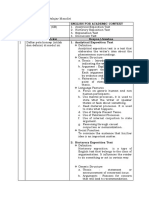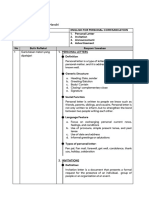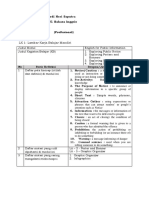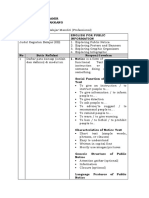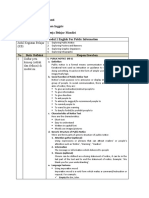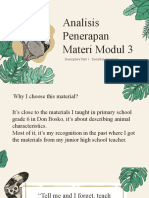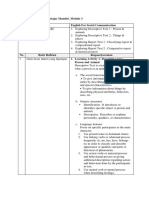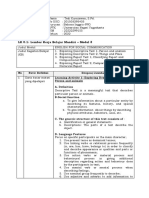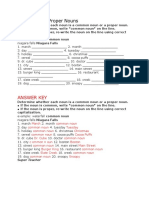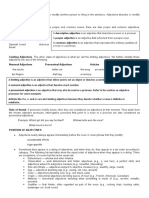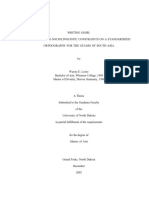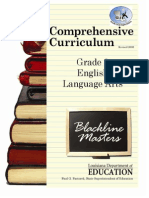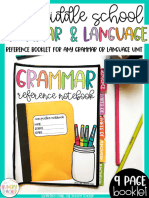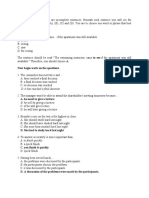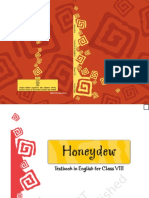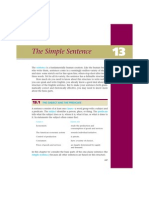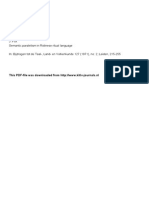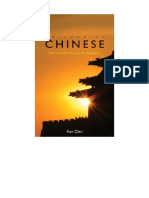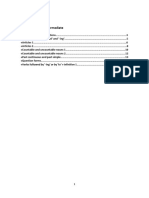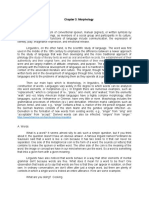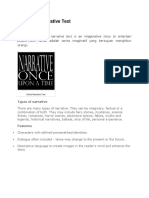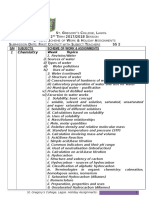Professional Documents
Culture Documents
LK 1 - Modul 3 Profesional
LK 1 - Modul 3 Profesional
Uploaded by
Taufik Ansyari100%(2)100% found this document useful (2 votes)
126 views3 pagesThis document contains a summary of key concepts from an English Social Communication module including descriptive texts about people, animals, things and places as well as different types of report texts. It defines descriptive text as text that describes single entities through identification, descriptions of characteristics and language features like present tense verbs. Report texts are defined as informing about categories rather than events using technical language and genres include classifying, compositional, comparative and historical reports. Comparative reports compare similarities and differences between entities while historical reports provide information about historical periods or sites through general statements and descriptions of features, activities, artifacts and significance.
Original Description:
Original Title
3. LK 1 - MODUL 3 PROFESIONAL
Copyright
© © All Rights Reserved
Available Formats
DOCX, PDF, TXT or read online from Scribd
Share this document
Did you find this document useful?
Is this content inappropriate?
Report this DocumentThis document contains a summary of key concepts from an English Social Communication module including descriptive texts about people, animals, things and places as well as different types of report texts. It defines descriptive text as text that describes single entities through identification, descriptions of characteristics and language features like present tense verbs. Report texts are defined as informing about categories rather than events using technical language and genres include classifying, compositional, comparative and historical reports. Comparative reports compare similarities and differences between entities while historical reports provide information about historical periods or sites through general statements and descriptions of features, activities, artifacts and significance.
Copyright:
© All Rights Reserved
Available Formats
Download as DOCX, PDF, TXT or read online from Scribd
Download as docx, pdf, or txt
100%(2)100% found this document useful (2 votes)
126 views3 pagesLK 1 - Modul 3 Profesional
LK 1 - Modul 3 Profesional
Uploaded by
Taufik AnsyariThis document contains a summary of key concepts from an English Social Communication module including descriptive texts about people, animals, things and places as well as different types of report texts. It defines descriptive text as text that describes single entities through identification, descriptions of characteristics and language features like present tense verbs. Report texts are defined as informing about categories rather than events using technical language and genres include classifying, compositional, comparative and historical reports. Comparative reports compare similarities and differences between entities while historical reports provide information about historical periods or sites through general statements and descriptions of features, activities, artifacts and significance.
Copyright:
© All Rights Reserved
Available Formats
Download as DOCX, PDF, TXT or read online from Scribd
Download as docx, pdf, or txt
You are on page 1of 3
LK 3: Lembar Kerja Belajar Mandiri
Judul Modul English Social Communication
Judul Kegiatan Belajar (KB) 1. Exploring Descriptive text à Person & Animals
2. Exploring Descriptive text à Things & Place
3. Exploring Report text 1 à Clasifying report & compositional report
1. Exploring report text 2 à Comparative report & historical report
No Butir Refleksi Respon/Jawaban
1 Daftar peta konsep (istilah dan Descriptive text (person and animal)
definisi) di modul ini 1. Definition :
Is a text that usually describing, single location, object, event,
person or place
2. Social function :
a. To give information about a particular entity by describing its
features, history, and special haracteristics.
b. To give information about things by describing physical
attributes, behaviors, uses, etc
3. Generic structure :
a. Identification or general statements. It introduces or
identifies specific object (a person and animal).
b. Descriptions: The parts of a text describe the object
characteristics, appeareances, personality, habits or
qualities
4. Language Features :
a. Focus on specific participants as the main character;
b. Use present tense as dominant tenses;
c. Use linking verbs or relational process frequently (is, are,
has, have, belongs to) in order to classify and describe
appearance or qualitiesand parts or functions of
phenomena;
d. Use action verbs or material process and behavioural
process in giving additional description regarding action
and behaviour done by the participants in text;
e. Use mental verb or mental process when describing
feelings;
f. Use nominal group frequently to describe;
g. Use adjective and adverbs to add information to nouns
and add information to verbs to provide more detailed
description about the topic;
h. Use adverbial phrases to add more information about
manner, place, or time and sometimes realized
nembedded clause which functions as circumstances
Descriptive text (thing and place) :
5. Definition :
Is a text that usually describing, single location, object, event,
person or place
6. Social function :
a. To give information about a particular entity by describing its
features, history, and special characteristics.
b. To give information about things by describing physical
attributes, behaviors, uses, etc.
7. Generic structure :
a. Identification or general statements. It introduces or
identifies specific object (a person and animal).
b. Descriptions: The parts of a text describe the object
characteristics, appeareances, personality, habits or
qualities
8. Language Features :
a. Specific participant : it has a certain object, is not common and
unique (only one).
example: Bandengan beach, my house, Borobudur
temple.
b. The use of the adjective (an adjective) to clarify the
noun
example: a beautiful beach, the famous place in jepara,
etc.
c. The use of simple present tense: The sentence pattern
used is simple present because it tells the fact of the
object described.
d. Action verb: verbs that show an activity
(i.e, run, sleep, walk, cut etc….
e. using passive voice
f. using noun phrase
g. using technical terms
h. using general and abstract noun.
i. using conjunction of time and cause-effect
9. Kind of Descriptive text :
a. Description of person
b. Description of animal
c. Description of thing
d. Description of place
Report Text (Classifying and Compositional Reports)
1. Definition
Report texts are texts which concerned with general categories
of things rather than events and happenings and with informing
about technical and scientific topics. Because of this, they can
seldom be interpreted and constructed without knowledge of
the field and itsassociated language (Derewianka 2016, p. 160).
2. Social Function
3. Classifying Report = To organise and describe a field or topic into
a class and subclass hierarchy
4. Compositional Report = To Organise and describe a field or topic
according to its part (a part or whole part)
a. General classification
General Clasification ; Stating classification of general aspect
of thing; animal, public place, plant, etc which will be
discussed in general
b. Description
tells what the phenomenon under discussion ; in terms of
parts, qualities, habits or behaviors.
5. Language features
Use of general nouns, eg hunting dogs, rather than
particular nouns, eg our dog;
Use of relating verbs to describe features, eg Molecules are
tiny particles;
Some use of action verbs when describing behaviour, eg
Emus cannot fly;
Use of timeless present tense to indicate usualness, eg
Tropical cyclones always begin over the sea;
Use of technical terms, eg Isobars are lines drawn on a
weather map;
Use of paragraphs with topic sentences to organise bundles
of information; repeated naming of the topic as the
beginning focus of the clause.
Report Text (Comparative report & Historical Report)
6. Definition
Report text is a text to organise and describe a field or topic into
a class and subclass hierarchy. Moreover, it can be used to
organise and describe a field or topic according to its part (a part
or whole part)
7. Social Function
a. Comparative report = to identify the similarities and
differences between two or more classes or things.
b. Historical report = to give information about the way things
were in relation to a particular historical period or site.
8. Generic Structure
a. Comparative report are typically structured as follows:
- General statement:
It introduces entities to be compared
- Description:
It contains the systematic analysis of similarities and
differences
b. Historical report are typically structured as follows:
- General statement
It identifies historical period or site and it defines and
locates in time and place.
- Description
Features or characteristics
Activities
Behaviour
Artefacts
Historical significance
9. Language feature
Use of general nouns, e.g hunting dogs, rather than
particular nouns, e.g our dog;
Use of relating verbs to describe features, e.g Molecules are
tiny particles;
Some use of action verbs when describing behaviour, e.g
Emus cannot fly;
Use of timeless present tense to indicate usualness, e.g
Tropical cyclones always begin over the sea;
Use of technical terms, e.g Isobars are lines drawn on a
weather map;
Use of paragraphs with topic sentences to organise bundles
of information; repeated naming of the topic as the
beginning focus of the clause.
2 Daftar materi yang sulit 1. Language features of Report text (Classifying, Compositional,
dipahami di modul ini Comperative and Historical report)
2. Generic Structure of Report text (Classifying, Compositional,
Comperative and Historical report)
3 Daftar materi yang sering Classifying, Compositional, Comperative and Historical report.
mengalami miskonsepsi
You might also like
- K 12 Curriculum Guide in EnglishDocument140 pagesK 12 Curriculum Guide in EnglishMinnie Phu85% (33)
- Time Zones: Third EditionDocument24 pagesTime Zones: Third EditionRusty AlvesNo ratings yet
- LK Modul 5 English For Practical UseDocument5 pagesLK Modul 5 English For Practical UseSari Febrianti100% (1)
- LK 1 - Profesional - Bahasa Inggris - Modul 1Document5 pagesLK 1 - Profesional - Bahasa Inggris - Modul 1adi100% (2)
- LK 1 PROFESIONAL MODUL 4 Lembar Kerja Belajar MandiriDocument4 pagesLK 1 PROFESIONAL MODUL 4 Lembar Kerja Belajar MandiriMohammad Daifi Ibrahim100% (3)
- Nur Annisa MR - LK - 1.modul 1 Profesi - Bahasa InggrisDocument4 pagesNur Annisa MR - LK - 1.modul 1 Profesi - Bahasa InggrisNur Annisa Mei RizkiNo ratings yet
- LK Modul 4 English For EntertainmentDocument7 pagesLK Modul 4 English For EntertainmentSari FebriantiNo ratings yet
- Analisis Modul 5 New Bahasa Inggris PPG 2021Document10 pagesAnalisis Modul 5 New Bahasa Inggris PPG 2021petra7aw100% (4)
- LK 1-Profesional - Bahasa Inggris - Modul 3Document5 pagesLK 1-Profesional - Bahasa Inggris - Modul 3adiNo ratings yet
- LK 1 - Modul 3 English For Social Communication - 201506473786 Syamsul BahriDocument5 pagesLK 1 - Modul 3 English For Social Communication - 201506473786 Syamsul Bahriabu HanifahNo ratings yet
- Nur Annisa MR - LK - 1.modul 3 Profesi - Bahasa InggrisDocument4 pagesNur Annisa MR - LK - 1.modul 3 Profesi - Bahasa InggrisNur Annisa Mei RizkiNo ratings yet
- LK Modul 3 English For Social CommunicationDocument6 pagesLK Modul 3 English For Social CommunicationSari FebriantiNo ratings yet
- Utin Nur'aini - LK 1.1 - Modul 3 English For Social CommunicationDocument3 pagesUtin Nur'aini - LK 1.1 - Modul 3 English For Social Communicationutin nuraini100% (1)
- Profesional - Modul 3Document4 pagesProfesional - Modul 3agustina kurnianingsih100% (1)
- LK 1-Profesional - Bahasa Inggris - Modul 4Document6 pagesLK 1-Profesional - Bahasa Inggris - Modul 4adi67% (3)
- LK 1: Lembar Kerja Belajar Mandiri: English For Personal CommunicationDocument2 pagesLK 1: Lembar Kerja Belajar Mandiri: English For Personal CommunicationDienha HabibieNo ratings yet
- Nur Annisa MR - LK - 1.modul 4 Profesi - Bahasa InggrisDocument5 pagesNur Annisa MR - LK - 1.modul 4 Profesi - Bahasa InggrisNur Annisa Mei Rizki100% (1)
- LK 1: Lembar Kerja Belajar Mandiri: English For Practical UseDocument2 pagesLK 1: Lembar Kerja Belajar Mandiri: English For Practical UseDienha HabibieNo ratings yet
- LK.1.1 Modul 1-6 (Profesi) - Misna NurbaytiDocument31 pagesLK.1.1 Modul 1-6 (Profesi) - Misna NurbaytiMisna Noerbayti100% (1)
- Nur Annisa MR - LK - 1.modul 6 Profesi - Bahasa InggrisDocument5 pagesNur Annisa MR - LK - 1.modul 6 Profesi - Bahasa InggrisNur Annisa Mei RizkiNo ratings yet
- LK 1 - Modul 1 PrefesionalDocument5 pagesLK 1 - Modul 1 PrefesionalTaufik AnsyariNo ratings yet
- Nur Annisa MR - LK - 1.modul 5 Profesi - Bahasa InggrisDocument4 pagesNur Annisa MR - LK - 1.modul 5 Profesi - Bahasa InggrisNur Annisa Mei RizkiNo ratings yet
- LK 1: Lembar Kerja Belajar MandiriDocument2 pagesLK 1: Lembar Kerja Belajar MandiriArga Dwi AfandiNo ratings yet
- LK 1.1 Modul 2 ProfesionalDocument3 pagesLK 1.1 Modul 2 ProfesionalDwi Wahyuni100% (1)
- LK 1: Lembar Kerja Belajar Mandiri: Nama: Medi Heri Saputra Kelas: 001 Bahasa Inggris Modul: 5 (Profesional)Document1 pageLK 1: Lembar Kerja Belajar Mandiri: Nama: Medi Heri Saputra Kelas: 001 Bahasa Inggris Modul: 5 (Profesional)medyputraNo ratings yet
- LK 1 - Modul 1 English For Public Infomation - 201506473786 Syamsul BahriDocument6 pagesLK 1 - Modul 1 English For Public Infomation - 201506473786 Syamsul Bahriabu Hanifah100% (1)
- Nur Annisa MR - LK - 1.modul 2 Profesi - Bahasa InggrisDocument4 pagesNur Annisa MR - LK - 1.modul 2 Profesi - Bahasa InggrisNur Annisa Mei RizkiNo ratings yet
- Tugas Akhir Modul 1 Profesional Bahasa InggrisDocument4 pagesTugas Akhir Modul 1 Profesional Bahasa InggrisEnow Nggongu100% (1)
- LK 1.2-Modul 4-Medi Heri SaputraDocument2 pagesLK 1.2-Modul 4-Medi Heri SaputramedyputraNo ratings yet
- LK 1: Lembar Kerja Belajar Mandiri: No Butir Refleksi Respon/JawabanDocument2 pagesLK 1: Lembar Kerja Belajar Mandiri: No Butir Refleksi Respon/JawabanArga Dwi AfandiNo ratings yet
- LK 1 - Modul 6 ProfesionalDocument4 pagesLK 1 - Modul 6 ProfesionalIka Syakira Asesoris100% (1)
- LK 1.1: Lembar Kerja Belajar Mandiri (Modul 1 - Profesional)Document4 pagesLK 1.1: Lembar Kerja Belajar Mandiri (Modul 1 - Profesional)Arman DullahNo ratings yet
- LK 1 - Modul 5 English For Practical Use - 201506473786 Syamsul BahriDocument5 pagesLK 1 - Modul 5 English For Practical Use - 201506473786 Syamsul Bahriabu Hanifah100% (3)
- English For Academic Context: LK 1: Lembar Kerja Belajar Mandiri Modul 6Document2 pagesEnglish For Academic Context: LK 1: Lembar Kerja Belajar Mandiri Modul 6yzoone100% (1)
- LK 1 Modul I English For Public InformationDocument4 pagesLK 1 Modul I English For Public InformationAnto BuddyNo ratings yet
- LK 0.1 PPG Bahasa InggrisDocument7 pagesLK 0.1 PPG Bahasa InggrisAnnah SwanNo ratings yet
- LK 2 Modul 5 English For Practical Use - Dwi KurniawanDocument2 pagesLK 2 Modul 5 English For Practical Use - Dwi KurniawanMernawati Kurniawan100% (1)
- LK 1 - Profesional English For Public InformationDocument4 pagesLK 1 - Profesional English For Public InformationAnto Buddy100% (1)
- LK 1 - Profesional English For Personal CommunicationDocument3 pagesLK 1 - Profesional English For Personal CommunicationAnto BuddyNo ratings yet
- LK 1: Lembar Kerja Belajar Mandiri: English For Academic ContextDocument4 pagesLK 1: Lembar Kerja Belajar Mandiri: English For Academic ContextDienha HabibieNo ratings yet
- LK 0.1 Modul 2 Bahasa Inggris - Frian SaputraDocument3 pagesLK 0.1 Modul 2 Bahasa Inggris - Frian SaputraFrian Saputra100% (1)
- LK 1 PROFESIONAL MODUL 2 Lembar Kerja Belajar MandiriDocument3 pagesLK 1 PROFESIONAL MODUL 2 Lembar Kerja Belajar MandiriMohammad Daifi IbrahimNo ratings yet
- LK 0.1 Lembar Kerja Belajar Mandiri Modul Bahasa Inggris 1 Tedi KurniawanDocument8 pagesLK 0.1 Lembar Kerja Belajar Mandiri Modul Bahasa Inggris 1 Tedi KurniawanKoko KurniaNo ratings yet
- LK 1 - Modul 2 ProfesonalDocument3 pagesLK 1 - Modul 2 ProfesonalTaufik AnsyariNo ratings yet
- Lk2 Modul6 Handayani SagalaDocument2 pagesLk2 Modul6 Handayani Sagalaayani1990100% (2)
- LK-1-Modul 1 - Profesional - Medi Heri SaputraDocument11 pagesLK-1-Modul 1 - Profesional - Medi Heri Saputramedyputra100% (1)
- LK 1-1Document4 pagesLK 1-1nursaida100% (2)
- LK 1 - Modul 2 English For Personal Communication - 201506473786 Syamsul BahriDocument5 pagesLK 1 - Modul 2 English For Personal Communication - 201506473786 Syamsul Bahriabu Hanifah100% (1)
- LK Modul 6 English For Academic ContextDocument5 pagesLK Modul 6 English For Academic ContexttyaoktrianiNo ratings yet
- LK 1 PROFESIONAL MODUL 6 Lembar Kerja Belajar MandiriDocument3 pagesLK 1 PROFESIONAL MODUL 6 Lembar Kerja Belajar MandiriMohammad Daifi Ibrahim100% (2)
- LK Modul 1 English For Public InformationDocument11 pagesLK Modul 1 English For Public InformationSari Febrianti100% (3)
- LK 1: Modul 5: No Butir Refleksi Respon/JawabanDocument1 pageLK 1: Modul 5: No Butir Refleksi Respon/Jawabansandy wijayaNo ratings yet
- Contoh Rubrik Penilaian Menulis Teks DeskriptifDocument2 pagesContoh Rubrik Penilaian Menulis Teks DeskriptifMulyadi Kemhai0% (1)
- Bahan Ajar Descriptive Text Miftakhul KhasanDocument6 pagesBahan Ajar Descriptive Text Miftakhul Khasanmahfiroh aminah100% (1)
- RPP Personal Letter ReadingDocument14 pagesRPP Personal Letter ReadinghiswiartiNo ratings yet
- LKPD Analytical ExpositionDocument4 pagesLKPD Analytical Expositionaisya syalindriNo ratings yet
- English For Practical UseDocument4 pagesEnglish For Practical Usenursaida100% (1)
- Analisis Penerapan Materi Modul 3: Descriptive Text 1: Describing AnimalsDocument15 pagesAnalisis Penerapan Materi Modul 3: Descriptive Text 1: Describing Animalspetra7awNo ratings yet
- LK 0.1 Lembar Kerja Belajar Mandiri - Modul 3Document5 pagesLK 0.1 Lembar Kerja Belajar Mandiri - Modul 3isti istiqomahNo ratings yet
- Modul Profesional 3Document3 pagesModul Profesional 3ainul yaqinNo ratings yet
- LK 0.1 Lembar Kerja Belajar Mandiri - Modul Profesional 1Document6 pagesLK 0.1 Lembar Kerja Belajar Mandiri - Modul Profesional 1sanniahmadNo ratings yet
- LK 0.1 Lembar Kerja Belajar Mandiri Modul Bahasa Inggris 3 Tedi KurniawanDocument5 pagesLK 0.1 Lembar Kerja Belajar Mandiri Modul Bahasa Inggris 3 Tedi KurniawanKoko KurniaNo ratings yet
- Tugas PPT Modul 5 ItineraryDocument5 pagesTugas PPT Modul 5 ItineraryTaufik AnsyariNo ratings yet
- LK 1 - Modul 5 ProfesionalDocument3 pagesLK 1 - Modul 5 ProfesionalTaufik Ansyari85% (13)
- LK 1 - Modul 1 PrefesionalDocument5 pagesLK 1 - Modul 1 PrefesionalTaufik AnsyariNo ratings yet
- LK 1 - Modul 2 ProfesonalDocument3 pagesLK 1 - Modul 2 ProfesonalTaufik AnsyariNo ratings yet
- SPEC 3 (Task 2)Document7 pagesSPEC 3 (Task 2)mary jane cahutayNo ratings yet
- Worksheets For Sem1Document9 pagesWorksheets For Sem1Shery MujosNo ratings yet
- Cee C1 RB TB R9Document16 pagesCee C1 RB TB R9Javier AmateNo ratings yet
- Topic 1 - Parts of SpeechDocument68 pagesTopic 1 - Parts of SpeechHano ShiNo ratings yet
- Proper: Articles Like The, A, and An Are Also Limiting Adjectives Because They Denote Whether A Noun Is Definite orDocument16 pagesProper: Articles Like The, A, and An Are Also Limiting Adjectives Because They Denote Whether A Noun Is Definite orhaniNo ratings yet
- Gujri Language ThesisDocument282 pagesGujri Language ThesisDr. Muhammad Ali DinakhelNo ratings yet
- Grade 8 - 02 English Art (Study)Document93 pagesGrade 8 - 02 English Art (Study)yyanan1118No ratings yet
- Grammar Notebooks Tabs Reference PagesDocument27 pagesGrammar Notebooks Tabs Reference PagesDaiana BaezNo ratings yet
- Now Begin Work On The Questions.: D. It Has Reached A Final DecisionDocument21 pagesNow Begin Work On The Questions.: D. It Has Reached A Final DecisionKhoirin Najiyyah Sably100% (1)
- Class 8 HoneydewDocument133 pagesClass 8 HoneydewAdhil muhammedNo ratings yet
- Grammar Book 623Document266 pagesGrammar Book 623Tejaswe KoriviNo ratings yet
- T16 PDFDocument22 pagesT16 PDFÁlvaro Sánchez AbadNo ratings yet
- ParallelismDocument4 pagesParallelismMaham ArshadNo ratings yet
- FINAL TEST - MikeDocument4 pagesFINAL TEST - MikeCarlos Carlitos BottinelliNo ratings yet
- PSY 369: Psycholinguistics: Second Language Acquisition: Critical Periods & BilingualismDocument29 pagesPSY 369: Psycholinguistics: Second Language Acquisition: Critical Periods & BilingualismJasper John RoqueNo ratings yet
- Unit 10-Empower-A2Document10 pagesUnit 10-Empower-A2dp1.1a1.trucNo ratings yet
- 123doc English Adverbs of Manner and Typical Errors Made by The Students at Le Hong Phong Specialised Secondary School Nam Dinh CityDocument56 pages123doc English Adverbs of Manner and Typical Errors Made by The Students at Le Hong Phong Specialised Secondary School Nam Dinh CityNgọc MaiNo ratings yet
- James Fox - Semantic Paralelism in Rotinese Ritual LanguageDocument42 pagesJames Fox - Semantic Paralelism in Rotinese Ritual LanguageAntonio Guerreiro JúniorNo ratings yet
- 1kan Qian Colloquial Chinese The Complete Course For Beginner PDFDocument484 pages1kan Qian Colloquial Chinese The Complete Course For Beginner PDFAntonina Tserk50% (2)
- Writing Quick GuidesDocument24 pagesWriting Quick GuidesMenon HariNo ratings yet
- Grammar British CouncilDocument89 pagesGrammar British CouncilAlfredo HernandezNo ratings yet
- Test Ingl..Document13 pagesTest Ingl..Ronald Amaya GaonaNo ratings yet
- Challenges 2 Godisnji PlanDocument2 pagesChallenges 2 Godisnji PlanMirosaki Sakimiro100% (2)
- II Sem BBA - B Com Study Material NEPDocument22 pagesII Sem BBA - B Com Study Material NEPRYS creationsNo ratings yet
- Parts of Speech JengaDocument14 pagesParts of Speech JengaFederico DuranNo ratings yet
- Morphology - Chapter 3Document5 pagesMorphology - Chapter 3Lopez, April Joy I.No ratings yet
- Pengertian Narrative TextDocument11 pagesPengertian Narrative TextAz'End D'free LoveNo ratings yet
- 2nd Holiday Assignment SS2 2018 FOR 3rd Term2 PDFDocument21 pages2nd Holiday Assignment SS2 2018 FOR 3rd Term2 PDFBukola RotimiNo ratings yet



